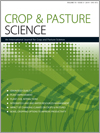Options for improving the yield and sustainability of the rice–wheat cropping system include the use of resource-conservation technologies such as no-till wheat, laser-assisted land levelling, and direct-seeded aerobic rice. Other useful strategies include seed priming, carbon trading and payment, the inclusion of legumes, and eco-friendly and biological methods of weed control. The persistent issue of burning crop residues could be resolved by incorporating these residues into biogas/ethanol and biochar production.

Crop and Pasture Science
Volume 70 Number 5 2019
CP19074Extending the duration of the ear construction phase to increase grain yield of bread wheat
This is the only wide-scale evaluation of variation in the duration between the terminal spikelet stage of development and flowering of wheat, known as the construction-phase duration (CPD). In 17 field experiments in south-eastern and Western Australia, a longer CPD was beneficial in moderately favourable rainfed environments with a relatively even distribution of rainfall. Our findings have implications for optimising sowing time through management and should improve the ability to predict crop development and extend CPD through breeding.
Identifying breeding lines with different amylose content is a significant procedure in the exploitation of mutants for implementing genome-editing technology in a wheat-breeding program. Eight wheat lines with different waxy proteins have been classified by near-infrared (NIR) and by Raman spectroscopy combined with chemometrics. The results demonstrated that Raman spectroscopy combined with chemometrics as a rapid method is superior to NIR spectroscopy in classifying eight partial waxy wheat lines with different waxy proteins.
Drought stress is one of the main limitations on crop production, and identification of drought-tolerance mechanisms is the first step for crop improvement under these conditions. Our results showed that higher antioxidant potential of foxtail millet than of proso millet resulted in its greater capacity to inhibit production of free oxygen radicals and made it more drought-tolerant species. However, efficient nitrogen supply and choosing appropriate planting date may moderate the negative effects of drought stress on plants through retention of metabolic activities.
CP18547Effect of genotype × environment × management interactions on chickpea phenotypic stability
Matching varieties with the right environment leads to optimal varietal performance, and conversely, a mismatch causes poor varietal performance. Chickpea varieties Sonali and PBA Slasher were stable under no-till environments. This will help farmers match varieties to environments.
CP19017Nutritional and anti-nutritional seed-quality traits of faba bean (Vicia faba) grown in South Australia
 , Jeffrey G. Paull, David G. D. Hughes, Beverley Gogel, Hao Long, Brett Williams, Sagadevan Mundree, Christopher L. Blanchard and Ken J. Quail
, Jeffrey G. Paull, David G. D. Hughes, Beverley Gogel, Hao Long, Brett Williams, Sagadevan Mundree, Christopher L. Blanchard and Ken J. Quail
The objective of this study was to evaluate the relative performance of 10 key varieties of faba bean for a range of nutritional and anti-nutritional seed quality traits. Predicted variety or variety × environment means and variance parameter estimates for the final fitted models are reported for moisture, seed weight, protein, total starch, amylose, amylopectin, percentage total starch, anti-nutritional factors vicine and convicine. This study will contribute to better understanding of nutritional and anti-nutritional properties of faba bean and will help the national breeding program to deliver better performing varieties for Australia’s key growing regions.



